Chief Kenneth Ellerbe

Our spotlight for the month of April is Chief Kenneth Ellerbe, Chief of the DC Fire and Emergency Medical Services Department, also called “DC FEMS.” Chief Ellerbe was hired as Chief of FEMS by Mayor Vincent Gray in 2010. He and his staff provide all-hazard services, including advanced life support care, to the residents and visitors of the District of Columbia. We will talk with him about his career with the Fire Department and as well about his goals and objectives for DC FEMS.
Destiny – Pride: Good morning, Chief Ellerbe. Destiny – Pride is delighted that you have accepted our invitation to be April’s Spotlight of the Month and we look forward to hearing about your life’s journey before you became the DC Fire and Emergency Medical Services Department’s Chief and about the goals and aspirations you now have for the Department.
We first will start off our usual way by asking you about your early life, so please tell us where and to whom you were born, your family structure, and any interesting experiences from your early life.
Chief Ellerbe: Okay. Well thank you first of all for this opportunity. I actually started as Chief in January 2011. I know that Vincent Gray made the announcement in 2010, but I started in 2011.
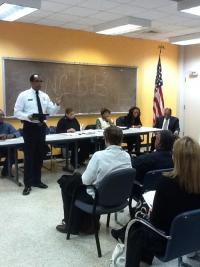
I’m from Washington, D.C.; I was born at the Washington Hospital Center to Vesta and William Ellerbe in April of 1960. I’m a native Washingtonian. My parents were raised in Washington as well. I went to Catholic school early – St. Benedict the Moor; Saint Francis Xavier. After the arrival of three more brothers, my parents moved to Northwest, DC – in 1969, after the riots – and I started going to Tacoma Elementary School. From there, I went to Paul Junior High, Calvin Coolidge Senior High, and then to the University of the District of Columbia. I guess you can say I’m a Washingtonian, through and through.
Destiny – Pride: I think so. [Laughter] Are you married and do you have any children?
Chief Ellerbe: I have one daughter. I am divorced.
Destiny – Pride: And what’s your daughter’s name?
Chief Ellerbe: I try to keep my daughter as far away from my public life as possible, though. She likes her privacy and I try to keep her away from the stuff that goes on at the Department.
Destiny – Pride: To whom would you attribute as having the greatest impact on you and your life?
Chief Ellerbe: It would be a lot of “to whom’s.” My mother and my father, for sure. My father was a very strong man, and my mother’s a strong woman, but the community itself had a lot of impact on me as well. My teachers; the Roving Leaders program; the DC Recreation Department and the people who managed the different recreation centers – including my mother. I spent a lot of time in a lot of different communities all over this city because, back in those days you didn’t have babysitters that came to the house. In the summertime, you went to work with mama, and my mother worked around the city in different recreation centers.

I also had a group of teachers at Calvin Coolidge High School that were very instrumental in my academic development. They encouraged me to read. They found out that I liked to read and they gave me a lot of projects to accomplish, and that gave me a sense of accomplishment. Every time I read a play by Shakespeare, or I read something like “Black Voices,” and got the positive feedback from them, it encouraged me to do more. I also had a baseball coach and a basketball coach who inspired me to pursue athletics, and that’s how I ended up going to UDC.
Destiny – Pride: What faith, if any, are you and how has that affected you and your life choices?
Chief Ellerbe: Absolutely! I was baptized Catholic and, in the early ‘80s, I converted to being a Baptist.
Destiny – Pride: Oh, shame on you – and thank you! [Laughter]
Chief Ellerbe: And during the process, I met a guy by the name of David Durham at Mount Sinai Baptist Church, where I joined in 1986, and I’ve been a member there ever since. That faith has sustained me through all of the different challenges – the job, my personal life – and it sustains me today. You know, when you’re in these public positions, you can always expect that there’s going to be some sort of challenge. On Sundays I can go back to church and get my soul and my spirit restored. It’s nothing like going to a praying place and having folks say, “You know, Chief, we’re praying for you,” or “Kenneth, we have you in our prayers,” and I really appreciate that. I want them to know that I appreciate that.
Destiny – Pride: Being a fireman is one of those careers that boys think about at a very early age. Was that one of your earlier dreams? Explain to our visitors what it was that inspired you to become a fireman.

Chief Ellerbe: Well, I became a firefighter after I walked out of a music appreciation class at UDC. [Laughter]. I had a fire truck that actually squirted water when I was five-years old. I hooked it up to the hose at the front of the house, and it would actually squirt water, but I didn’t really pursue, or have a “passion” for firefighting until after I joined the Department. I came out of the music class and I saw a poster that said “We want you!,” and it had a black firefighter on it, carrying a black baby out of a building. I had taken a psychological battery – the Myers Briggs Battery. It said I was best suited for military or paramilitary organizations. So I decided to start pursuing those opportunities so that when I graduated, I would be in a field that I enjoyed. I thought I would only be a firefighter for five years, and then I’d go back to school and get a law degree. But, by the third year, I really realized that this probably was the best place for me. I enjoyed the job. I enjoyed the people that I worked with, and I enjoyed meeting people in the community and being able to help them, particularly in areas and environments where most folks wouldn’t want to go in the first place – and I mean a firefighting situation, or a help crisis. So I’m having a good time. I started off having a good time, and I’m still having a good time!
Destiny – Pride: Take us on a brief journey of your career from the beginning up to your being made the Chief of FEMS. You did talk on it, but you skipped over some of it, because I’m quite sure that you didn’t start off as Chief . . .
Chief Ellerbe: No, no.
Destiny – Pride: . . . so help us with that journey.
Chief Ellerbe: It’s been an almost thirty-year journey. I don’t know how “brief” you can call that but, coming from Washington, DC, we have a certain culture here. The fire service has its own culture. Some of it is steeped in tradition, and if you don’t know those traditions . . . . My father wasn’t a firefighter. A lot of times, it’s a family tradition for sons to follow fathers into this field. I’m the first generation firefighter in my family. My father liked the fire trucks, but he never became a fireman, which means I had to “assimilate,” to some degree, into a new culture.
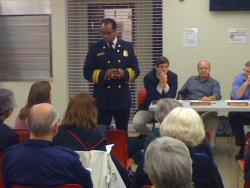
As a firefighter, I spent five years in Southeast, so I was very comfortable there. After doing the five years there, I went to Fire Prevention; had a desk job for about four years. I left there to go back out in the field as a Sergeant and soon became Lieutenant thereafter. Back in far Northeast, over near the Shrimp Boat – if people know DC, they know where the Shrimp Boat is – I spent four years there as a firefighting officer in a very busy company. We did a lot of medical calls, but we also did a lot of firefighting, too. After four years there, I made Captain and was sent back downtown to Fire Prevention, where we had a new Deputy Chief, and I helped him run that Division successfully. I was promoted to Battalion Chief a year after I arrived.
As the Battalion Chief, I spent some time there, but I also went back in the field again as a Field Commander. I had one of the busier firefighting battalions – Battalion One – which was a hazardous materials battalion as well. Then, in 2000, I became Interim Fire Chief very briefly. There was a vacuum at the top. I had applied for the job as Fire Chief – even though I was only a Battalion Chief – and the Mayor appointed me very briefly, until we had a new Chief come in. When the new Chief came in, I left as a Deputy and went from the Fire Prevention Division to the Fleet Maintenance Division, to Facilities Maintenance and Logistics and Maintenance, and Fire Prevention Division. I was a Division Commander in just about every division in the Department, which gave me a very good idea of how the Department was run and how the different facets all come together to make this one whole department.
I left in 2009 as a Deputy Chief to be the Fire Chief in Sarasota, Florida. Sarasota is extremely different from Washington, DC. It’s one of the richest counties in Florida; has a five percent minority population, which means that I was the first African American Chief there, but it also meant that I was part of a very small population in a larger population, and that was a learning experience for me because it was different from DC. I think I was fairly successful there. Some of the programs that I put in place are still in effect there. They’re still using them in terms of cost-saving measures. Fortunately for me, when Vincent Gray was elected, I applied for the Chief position there and he accepted my application.
Destiny – Pride: Have you had any fascinating experiences as a firefighter that you would like to share with our visitors?
Chief Ellerbe: [Laughter] I have had a whole lot of “fascinating” experiences. Just thinking back, the most fascinating thing anybody could ever see is a child being born, and I have been there on six different occasions when new life entered into the world.
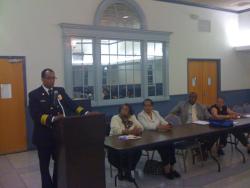
I worked on 911; I was the Division Commander of the Operations Division on 911, and went into the Pentagon to see what had occurred. I sent Companies over to the Pentagon, including my youngest brother. My mom wasn’t too happy about that, but he was a Lieutenant at the time. That was pretty fascinating. I went to New York to be part of the review process – to look at what they did, and bring that valuable information back, and I’m always going to have that in the back of my mind when it comes to making those critical decisions.
I met the President, and that was pretty fascinating. Shaking hands with President Barack Obama was probably a high point in my career because knowing what he’s going through, and seeing what he’s going through makes everything else just seem a little bit less.
Destiny – Pride: At one period in time, the Fire Department and the Emergency Medical Service in DC were separate entities. Briefly describe the functions of each back then.
Chief Ellerbe: Well back then, firefighting was strictly part of what the Fire Department did. The Fire Department merged with Emergency Care and became the Emergency Medical Services Bureau. The Emergency Medical Services Bureau is responsible for pre-hospital care, treating sick and injured, and making sure they’re transported to the hospital as quickly as they possibly can.
Merging those two very separate public safety objectives is not easy. Some people join the Fire and EMS Department strictly to be firefighters, and they have very little interest in pre-hospital care. Some people join the pre-hospital care side and have very little interest in being firefighters or all-hazard mitigators. So trying to encourage folks to embrace both of those objectives is not always easy. There’s some resistance. The benefit for the community is that you have a well-trained, well-rounded individual who can provide different types of services, and that’s why we’re trying to move in that direction.
We have been slowly, carefully, methodically, doing that, and I’m happy to say that probably 98 percent of our employees can provide all-hazard care, meaning they can fight fires; they can mitigate hazardous materiel events; they can also provide pre-hospital care.
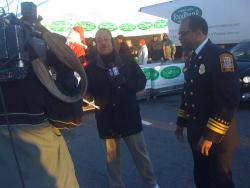
Destiny – Pride: What was the rationale for joining them as one unit? You did speak about it, but I noticed that you also briefly, in an op-ed piece, were more detailed in describing the benefits and cost savings and all of that. Would you like to take the opportunity to talk on that?
Chief Ellerbe: Sure! Blending Fire and EMS gives you a bigger “bang” for your buck, in terms of being a taxpayer. You have an employee that can provide a variety of services, as opposed to one particular service, which means you don’t need as many employees. It also means that the equipment that they use can be consolidated. Sometimes we have 2 to 4 emergency medical technicians on a fire truck, which means those guys and ladies can go put out a fire, or they can provide life-saving activities and life-saving services. So the idea of blending them both together just makes us more efficient.
Destiny – Pride: Also in the op-ed you gave some stats, which were astounding to me, one of which was that 85 percent of all of your calls are not necessarily for medical, right?
Chief Ellerbe: No, actually 85 percent of the calls “are” medical. Between 80 and 85 percent of our call volume is pre-hospital care based or injury based. Out of the 166,000 calls we ran last year, I think about 900 of those calls were fire-related; and of those 900 – and that’s an approximation – I think about 460 were actually fire-related, where a fire occurred. Now that is a small percentage in terms of the number of calls we make, which shows us that our buildings are safer; our fire prevention initiatives are working; people are being more careful about the cause of fire. But we’re getting older. With the benefits of medicine, we’re living longer, which means that we may be subjected to different ailments. And as our communities age, as our populations, age, there’ll be more calls for us to provide pre-hospital care, and I think that’s where we need to start focusing our resources.
Destiny – Pride: I remember when they would, a lot of times, send a fire truck before an ambulance. Is that what you’re talking about? Help me to understand that.
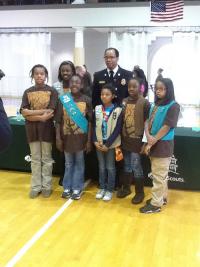
Chief Ellerbe: That’s what we do now, and I think that started around 1987. That’s part of how we do our business, but the reality is if we’re spending 70 percent of our capital funding on firefighting activities, but our actual operation is 85 percent pre-hospital care based, then we have to look at the return on investment; we have to look at how we allocate our resources, and make some adjustments. Fire trucks still arrive sometimes before ambulances because there are more of them and they are better located in terms of where they’re assigned. Our ambulances are on the streets all day long. The fire truck is probably sitting somewhere 70 percent of the time, which means that it is available to provide that pre-hospital care. We need to start looking at how we allocate our resources to make sure that what we do really meet the communities’ needs.
Destiny – Pride: I was jogging this morning and at 8th and Pennsylvania Avenue [Southeast] there was a man lying in the street. I called 911 and they said they were dispatching a police officer and an ambulance. The fire station is right there at Pennsylvania Avenue. It came relatively quick, but then right after, the fire truck came. Okay, the ambulance was on the scene and then the fire truck came right behind it.
Chief Ellerbe: Well the ambulance may have been dispatched before or after the fire truck. I don’t know what the order of dispatch was, but first let me say that I’m glad to hear you say that they came relatively quickly.
Destiny – Pride: They did.
Chief Ellerbe: That’s our primary concern and that’s why we send different units. We send as many units as we have available that will meet the need of that call as quickly as possible. Sometimes we may have an ambulance, a medic unit and a fire truck. The reality is there is somebody who can provide pre-hospital care on every one of those units. Now it may be that the ambulance didn’t cancel the engine company because they needed help. It just depends on the circumstances. The more resources we can throw at a problem like that to preserve life, the more resources we’re going to put to use.
Destiny – Pride: Truly I was impressed. It was maybe three to four, maybe five minutes.
Chief Ellerbe: You’re saying you were impressed?
Destiny – Pride: Yes. [Laughter]. You see, here’s what you have to understand. I’ve been jogging for 34 years and the last couple of weeks have been very warm, but it was really cool this morning and I was sweating, so I’m cold. So the dispatcher then asked, “Are you going to stay on the scene?” So I said, “Well, since I did my Christian duty to stop, I’m going to stay.” So I was standing there, but I was so glad that they did come so fast. I was going to ask the police if he could take me home because I was cold [laughter] after standing there!! [More laughter]
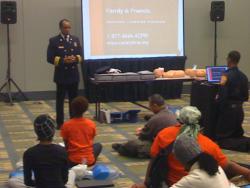
Chief Ellerbe: Well I tell you, we have one of the best Departments in the country in terms of response time and even in the care, and the attention – the detail – that our employees, my colleagues, pay to the different issues that they address. They are great firefighters and pre-hospital care is extremely good. I mean, if somebody had to model a system, I would hope that they would look at ours.
Destiny – Pride: What are your goals and objectives for the Department as a combined unit? You did speak about some. Are there any others?
Chief Ellerbe: Oh, absolutely! I want this Department to be, and I’m hoping that we as a Department can be more community focused, community based. I lot of times you can ride by a firehouse and the doors are down and people don’t know what’s going on in there. We’re a mystery to the community until they dial 911. I really want us to “unveil” the Department and become more accessible – get to know our community better and the community get to know us better. So we’re doing everything we can to get ourselves out there, introduce ourselves to people. When we think about promotion, we ask candidates for promotion, “How many people do you know in the neighborhood where you work?” I think those things will inspire and encourage us to get out, and hopefully encourage people to come in and talk to us.
I also want to see us as providing an opportunity for the young folks in the City to get a good job, to have a career. That’s one of the reasons why we reinstituted the Cadet Program. I think that working in the community where you live almost inspires you to do a good job. And it helps when young people see their friends become a member of the government, particularly in these public safety agencies. That’s another vision that I have: To provide opportunities for people here in Washington, DC for gainful employment.
Destiny – Pride: Well I truly know that you all have played a great role in that in the past, especially under Neighborhood Services, when all of us were forced to work together. That’s how, when you all were over at the Fire Marshal’s Office, I got a chance to meet Aleaz [Taylor] and Samone [Hoston]. I can speak firsthand on that and I’m glad that you are “restarting” that, because that has been somewhat a lost thing.
Destiny – Pride: What would you say has been a major accomplishment in your life and why?
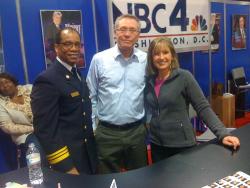
Chief Ellerbe: Major accomplishment in my life: the ability to inspire young people. We have a 34-member Cadet class right now. My daughter is a major accomplishment, and I won’t say any more about her because she’s really shy. The things that I’ve done professionally are not anywhere near as important to me as the things I’ve been able to do with people and for people. When I look out at the things that I’ve been able to accomplish, working with people, I figure those are my major accomplishments. The 34 kids that we have now and the ones we’ll hire in the future, and even starting the Cadet Program back up again when I had the opportunity earlier, and meeting people who say, “You know, you started the Cadet Program, and I remember when you did it!” Those are accomplishments to me.
Destiny – Pride: What about your major disappointments?
Chief Ellerbe: Well, let’s see. . .
Destiny – Pride: I know that this is really hard for a person that’s perfect. [Laughter]
Chief Ellerbe: No. I’m not perfect, but I’m trying to think. I don’t look at the challenges that I’ve had to be that many disappointments. I expect certain things from the Department that I work in and the community and sometimes my expectations might not be met. How I deal with it is probably more important, and we get past that kind of stuff.
One of the things that I’ve touched on that is probably most important is that church at 3rd and Q – Mount Sinai – which keeps me grounded and that helps me understand that all of our expectations will never be met, but that doesn’t mean that we stop having them. And that doesn’t mean that we get so down when they’re not met that we don’t move forward. So I’ve had a pretty good life so far, and I’m still having the time of my life. [Laugther]
Destiny – Pride: With your being the Chief of both the Fire and the Emergency Medical Services, what are your top safety concerns for the residents of the District of Columbia, and what suggestions can you give that will help them with those concerns?
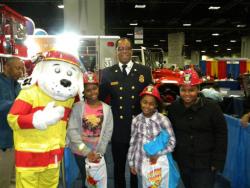
Chief Ellerbe: You know, I’m glad you asked me that because there are some silent dangers in our communities that we can all address relatively easy. Any time you see us out at these ANC meetings and these community meetings, we bring a group out that can test for high blood pressure and they can also test your glucose or do some diabetes screening. Those are two “preventable” challenges – or at least “manageable” challenges – that I want people to be aware of and I would hope that our entire Department would want people to be aware of. We are going to be community based. The more prevention that we can provide to the community, I think the better off the community will be.
We want people to be safe in their houses. We would hope that they have a smoke detector or carbon monoxide detector – or a combination unit, because if they live in Washington, DC, we’ll give them one. We don’t want anybody to be afraid to call us – 911 or 311 – if they need us. And to make sure that they are treated properly. We have a Patient Bill-of-Rights that assures that every person that dials 911 that we respond to is going to be treated fairly and be treated properly. I really want us to be embraced by the community, and I think that we can do that. The more we’re out, the more contact we have with people, the more people really get to know the Department, I think the safer they’ll feel and the safer they’ll be, because there’s always good advice that we can give them.
Destiny – Pride: What do you do to relax? Any hobbies or interests?
Chief Ellerbe: I work 24 hours a day, seven days a week! [Laughter] And I love my job first of all . . .
Destiny – Pride: But it’s something that you “sneak” in [more laughter].
Chief Ellerbe: I go to the gym 4 or 5 times a week, at least. I spend a couple of hours in the gym exercising – the cardio, aerobic work. I do a lot of free weights, heavy lifting. I swim and I try to go to the movies and places where people don’t know me.
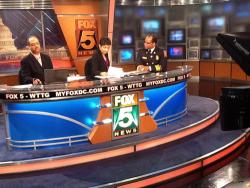
Destiny – Pride: Right. [Laughter]
Chief Ellerbe: I go to the library, too, sometimes. I very rarely run into a lot of my colleagues in the library.
Destiny – Pride: Ah, that’s terrible!
Chief Ellerbe: I go to the Library of Congress [laughter] and find a quiet place to read . . . [laughter]
Destiny – Pride: What are you trying to say? [Laughter]
Chief Ellerbe: They probably go to their local library [laughter].
Destiny – Pride: Yeah, sure you’re right!
Chief Ellerbe: I use my reader card at the Library of Congress [a lot more laughter].
Destiny – Pride: [Laughter] I’m sorry, Nancy!! Let me get myself together.
Chief Ellerbe: Yeah, I couldn’t resist! As you can see, I like to have fun!
Destiny – Pride: Chief, do you have any last words or thoughts that you would like to leave with our visitors?
To see the video of Chief Ellerbe’s response
To read his response, continue below.
Chief Ellerbe: Well, first I’d like to say thank you to Mayor Gray for giving me the opportunity to sit in this position as Chief of the Fire and EMS here in Washington, DC. I’d also like to thank Phil Mendelson for his oversight of the Judiciary Committee. And I’d like to thank our members and the community, because the way that we work together is the best way for us to provide service and safety to our communities. So, thank you for the opportunity. It’s been a pleasure talking to you and I look forward to seeing you again.
Chief Ellerbe: Well, first I’d like to say thank you to Mayor Gray for giving me the opportunity to sit in this position as Chief of the Fire and EMS here in Washington, DC. I’d also like to thank Phil Mendelson for his oversight of the Judiciary Committee. And I’d like to thank our members and the community, because the way that we work together is the best way for us to provide service and safety to our communities. So, thank you for the opportunity. It’s been a pleasure talking to you and I look forward to seeing you again.
Destiny – Pride: We thank you, Chief Ellerbe, for taking the time to be our Spotlight for April 2012. We recognize the importance of your position and of the work that you and your staff do to keep us safe and secure. We are grateful for your commitment to do all that you can to provide us with first-class and high-quality all-hazards protection. Thanks again.
Did you enjoy our conversation with Chief Ellerbe? Let us know how much by leaving a comment in the box provided below.
